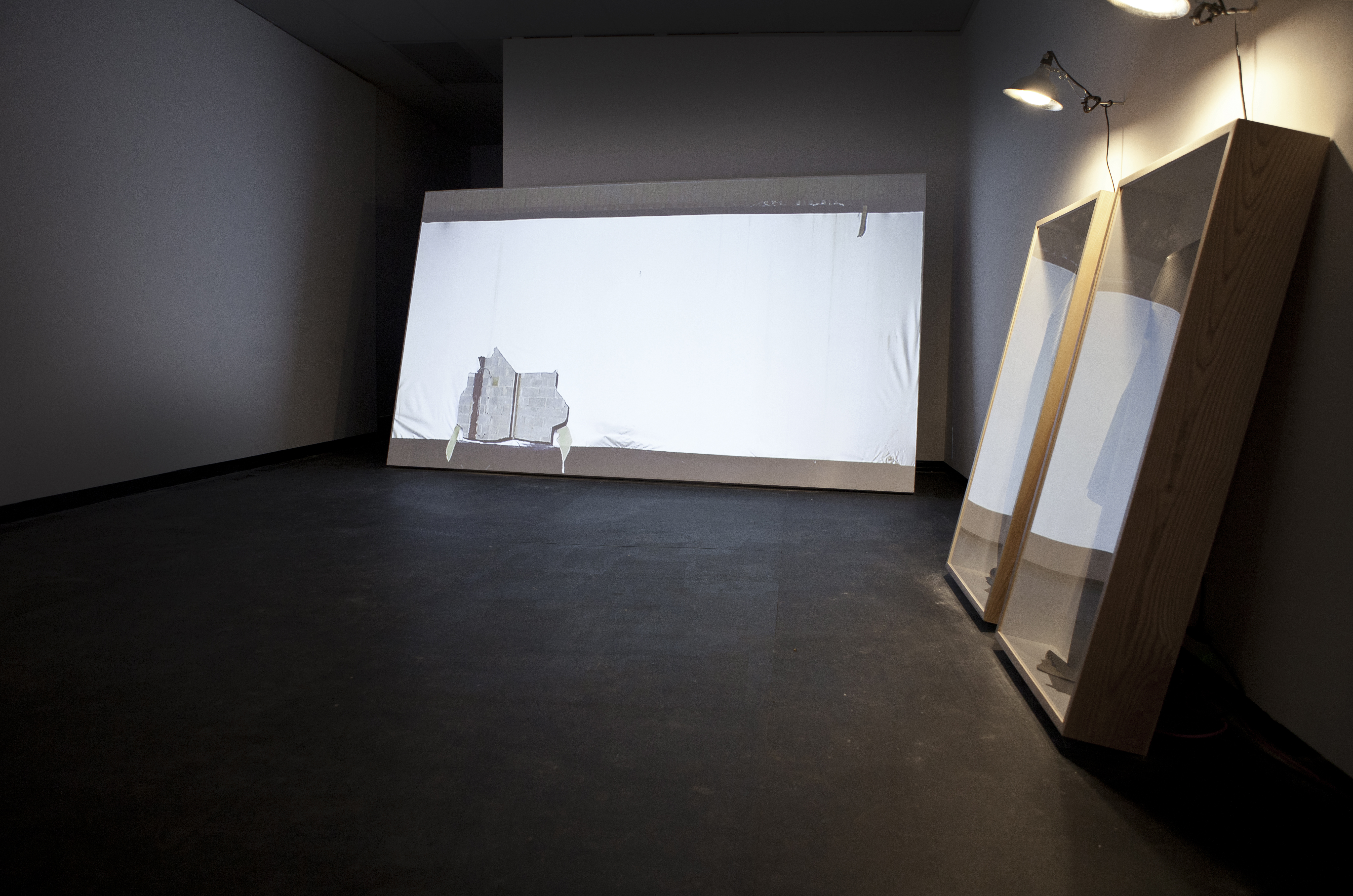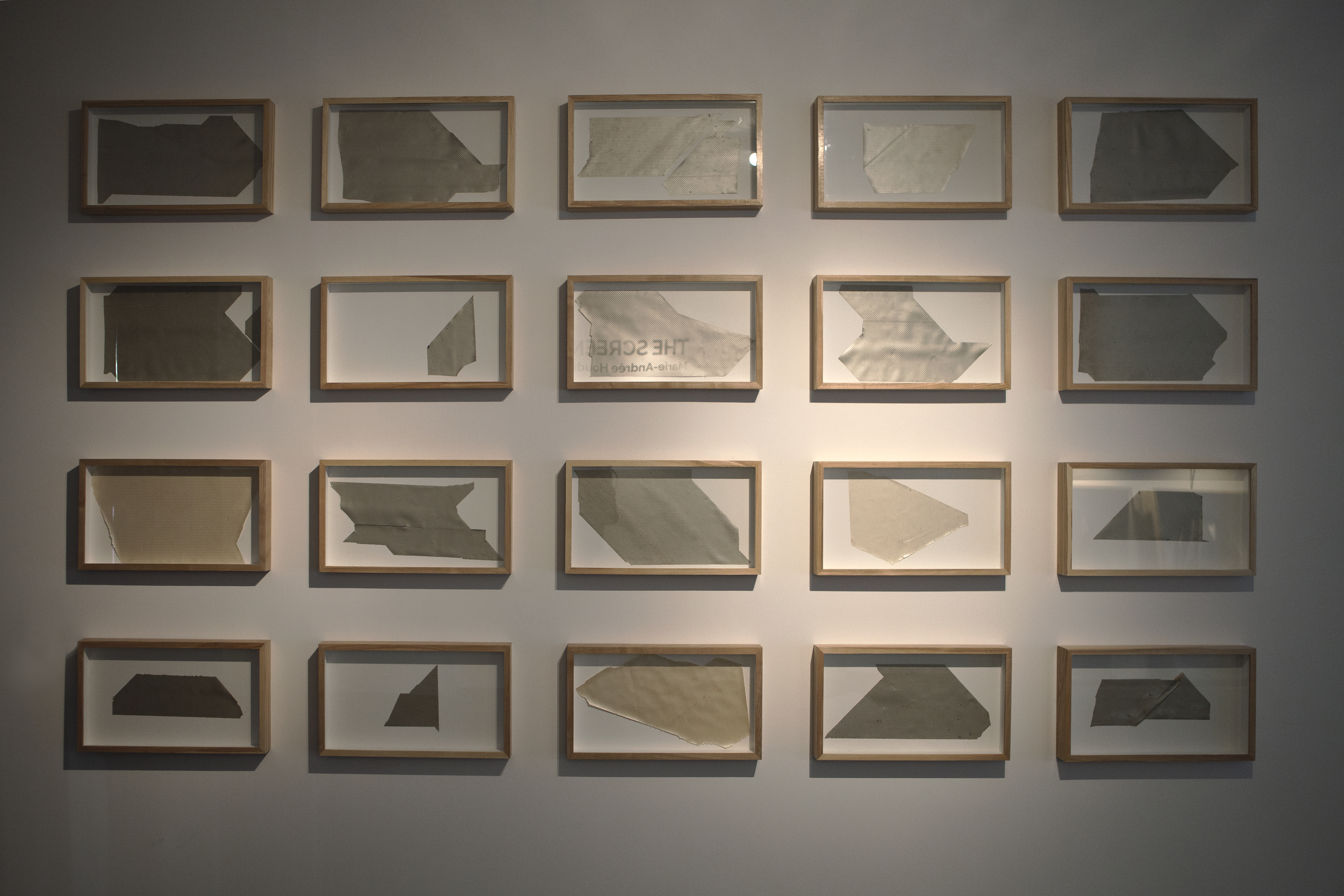MAINSPACE EXHIBITION /

The Screen
Marie-Andrée Houde
October 11 to November 2, 2013
In The Screen, the cinematic canvas is presented as a fantasized surface. Its materiality is emphasized, reflecting upon the cultural desires of cinematic representation. Marie-Andrée Houde considers the screen unmediated by fiction, returning its photogenic potential so that it might become its own protagonist. One can therefore approach the remains of the canvas as what it is: a representational surface where various celebrities appear and vanish as other epic moments, symbols, and desires somehow transcend their artificiality or not.
Marie-Andrée will be giving a talk about her work as part of the Visiting Artist and Scholar Lecture Series on Friday, October 11 at 10:00 AM in the Gallery Hall at the Taylor Family Digital Library, University of Calgary.
A Certain Iconoclasm
If we tend to believe that creating is but a means for the artist to express an interior will ripe for the picking, it more often happens that the work of art stems from a trigger. The Screen by Marie-Andrée Houde is a work derived from the awe-inspiring experience the artist had when she was granted access to the Ouimetoscope [1], the very first theatre entirely devoted to motion pictures North America. The artist proposes a minimalist exhibit that takes this familiar object usually destined to erase itself in order to collect images – the screen – and she endows it with the power to provoke aesthetic contemplation.
The exhibit includes the projection of a photograph illustrating the forsaken state of the movie theatre’s main screen as the artist discovered it: punctured at its centre, drip-stained, bearing the marks of time as if it had been worn by the images projected upon it long ago. The image slowly fades into a complete monochromatic vanishing that sheds white light onto the surface which thus materializes in front of us, before gently fading back to the original picture. Interacting with this re-presentation is a series of fragments taken from the original screen itself, presented side by side in boxes, and set in such a way as to recall the gaping hole borne by the screen being projected onto the even screen. These screen snippets are actually riddled with tiny equidistant holes themselves and, as real pieces of a celebrated past, indeed represent precious relics to collect, inasmuch as they remain the silent witnesses of an important part of Montréal’s cinematographic history.
More broadly, Houde is fascinated by what she calls “the fantasy of cultural representation”, a phenomenon exacerbated by motion pictures. Movies, the powerful media that create the illusion of spatial and temporal reconstitution, have generated a sort of contemporary mythology strewn with stars offered up as models for us to draw from in the process of forming our lives and identities. They respond to and generate the common impulse of staging oneself in the limelight, of making it onto the movie screen, of responding to varied representation contexts.
The Screen forces its visitors into an iconoclastic experience. The images that are revered no longer are the cinematographic ones. Gone are the stories, the celebrities, the music, the sets. The focus is diverted from the fiction and towards the support of movie projection. As a result, the referential system is levelled out, since we are brought back to the material fixtures required for the emergence and staging of the moving image. A semiotic tension is indeed created between the removed cinematographic content and the fetishized materiality of the plane surface on which it typically is projected. Not unlike the minimalist tendency to restore the objectal value of materials linked to art, the artist here flattens the signified, that is, the cinematographic tale, onto the signifier, the projection plane. The resulting open, abstract, poetic, and materialistic relationship would surely have pleased Roland Barthes, for whom: “[…] the highest form of artistic expression is on the side of literality, i.e., ultimately of a certain algebra: all form must tend toward abstraction, which, as we know, is not at all contrary to sensuality.” [2]
– Ève Dorais
Notes
[1] Founded in 1906 in Montréal by electrician and filmmaker Léo-Ernest Ouimet, the Ouimetoscope sat on Ste-Catherine Street and the corner of Montcalm Street. A real success story for nearly twenty years, it closed in 1922. Many different administrations took over thereafter and renamed the movie house, which regained its original name in 1967 and stayed open until 1993. The premises were then abandoned for several years until a real-estate promoter capitalized on the building’s glorious past and transformed it into opulent apartments.
[2] Roland Barthes, Mythologies. Translated by Richard Howard, Edition Hill and Wang, 2012, p. 190.



Biographies
Marie-Andrée Houde lives and works in Montréal. She holds a Master’s in Visual and Media Arts from Université du Québec à Montréal in 2009. Her work explores and deconstructs the process of representation observed through popular culture. She elaborates devices that, by means of dissociation principles, reshape the archetypal codes at play within the construction of images. She has gained support from the Conseil des arts et des lettres du Québec. Since 2006, her work has been presented in various group and individual exhibits in Québec, Belgium, France, and Poland. She has also participated in a number of artist residencies.
Ève Dorais holds a Fine Arts Bachelor’s degree and a Master’s degree in Art History from the Québec University in Montréal. She works in the visual arts community as an art exhibition and catalogue coordinator, as well as an author, curator, and artist. From 2007 to 2011, she was involved in DARE-DARE, a mobile artist run centre in Montreal. In 2007, she co-curated with Aude Moreau a series performances and installations event presented in partnership with Articule and Cedex (UQAM) called 11:1/1. She also curated recent works of Françoise Sullivan (Galerie Simon Blais, 2010) and was in the curatorial team of ORANGE 2012: an arts event that functions like a living laboratory to explore issues related to art and the agri-food industry through exhibitions, interventions, and seminars showcasing works of professionals artists from Quebec, from elsewhere in Canada and abroad. She is curating a group show at SKOL in Montréal in April 2014.
